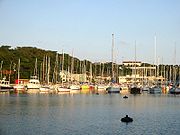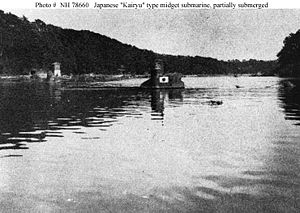
Aburatsubo
Encyclopedia


Miura Peninsula
is a peninsula located in Kanagawa, Japan. It lies south of Yokohama and Tokyo and divides Tokyo Bay, to the east, from Sagami Bay, to the west. Cities and towns on the Miura Peninsula include Yokosuka, Miura, Hayama, Zushi, and Kamakura....
facing Sagami Bay
Sagami Bay
Sagami Bay , also known as the Sagami Gulf or Sagami Sea, lies south of Kanagawa Prefecture in Honshū, central Japan, contained within the scope of the Miura Peninsula, in Kanagawa, to the east, the Izu Peninsula, in Shizuoka Prefecture, to the west, and the Shōnan coastline to the north, while the...
on the Pacific Ocean
Pacific Ocean
The Pacific Ocean is the largest of the Earth's oceanic divisions. It extends from the Arctic in the north to the Southern Ocean in the south, bounded by Asia and Australia in the west, and the Americas in the east.At 165.2 million square kilometres in area, this largest division of the World...
. It exits into neighbouring Moroiso
Moroiso
Moroiso is the name of an inlet in the Miura Peninsula south of Tokyo in Japan.- Prehistory :Moroiso was settled by Jōmon people by at least 3,000 BCE. Evidence from that period have been found, including sedentary to semi-sedentary housing, pottery, stone tools and fishing implements...
inlet.
History
During historic times, the Aburatsubo inlet was selected by the feudal MiuraMiura clan
The ' was one of the branch families descended from the Taira clan. They held large fiefs, and great political influence. They were one of the primary opponents of the Hōjō family of regents, in the mid-13th century, and again at the beginning of the 16th...
family to build a series of fortifications, with Arai castle at its center. During the Sengoku period
Sengoku period
The or Warring States period in Japanese history was a time of social upheaval, political intrigue, and nearly constant military conflict that lasted roughly from the middle of the 15th century to the beginning of the 17th century. The name "Sengoku" was adopted by Japanese historians in reference...
, the castle fell after a 3 year siege to the rival Late Hōjō clan
Late Hojo clan
The ' was one of the most powerful warrior clans in Japan in the Sengoku period and held domains primarily in the Kantō region.The clan is traditionally reckoned to be started by Ise Shinkurō, who came from a branch of the prestigious Ise clan, a family in the direct employment of the Ashikaga...
, in the year 1516. The Hōjō later managed to unify most of the Kantō
Kanto region
The is a geographical area of Honshu, the largest island of Japan. The region includes the Greater Tokyo Area and encompasses seven prefectures: Gunma, Tochigi, Ibaraki, Saitama, Tokyo, Chiba, and Kanagawa. Within its boundaries, slightly more than 40 percent of the land area is the Kantō Plain....
.
According to some stories, the name Aburatsubo ("Oil Vase"), comes from the time when hundreds of samurai
Samurai
is the term for the military nobility of pre-industrial Japan. According to translator William Scott Wilson: "In Chinese, the character 侍 was originally a verb meaning to wait upon or accompany a person in the upper ranks of society, and this is also true of the original term in Japanese, saburau...
, fleeing the troops of Hōjō, drowned in the waters of the inlet and left it a sea of blood.

